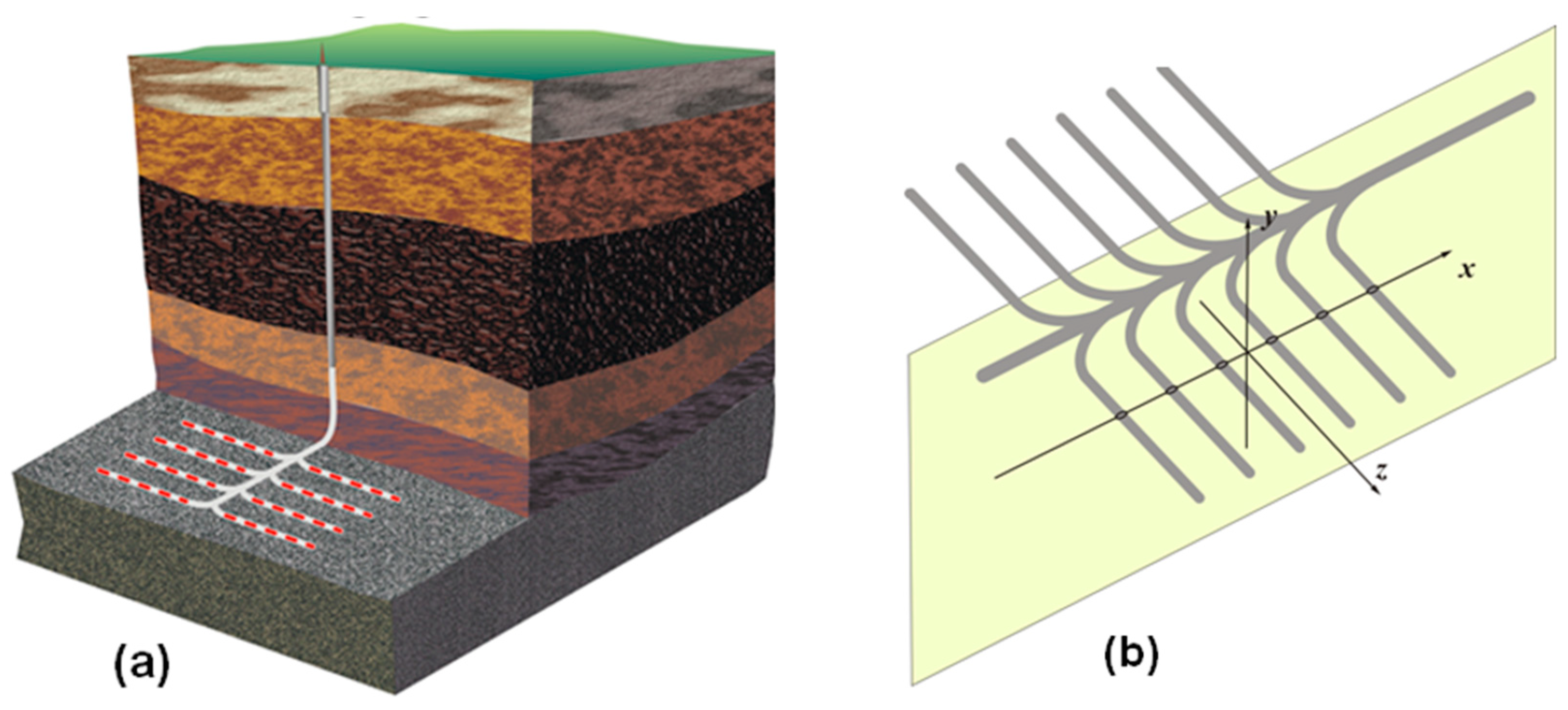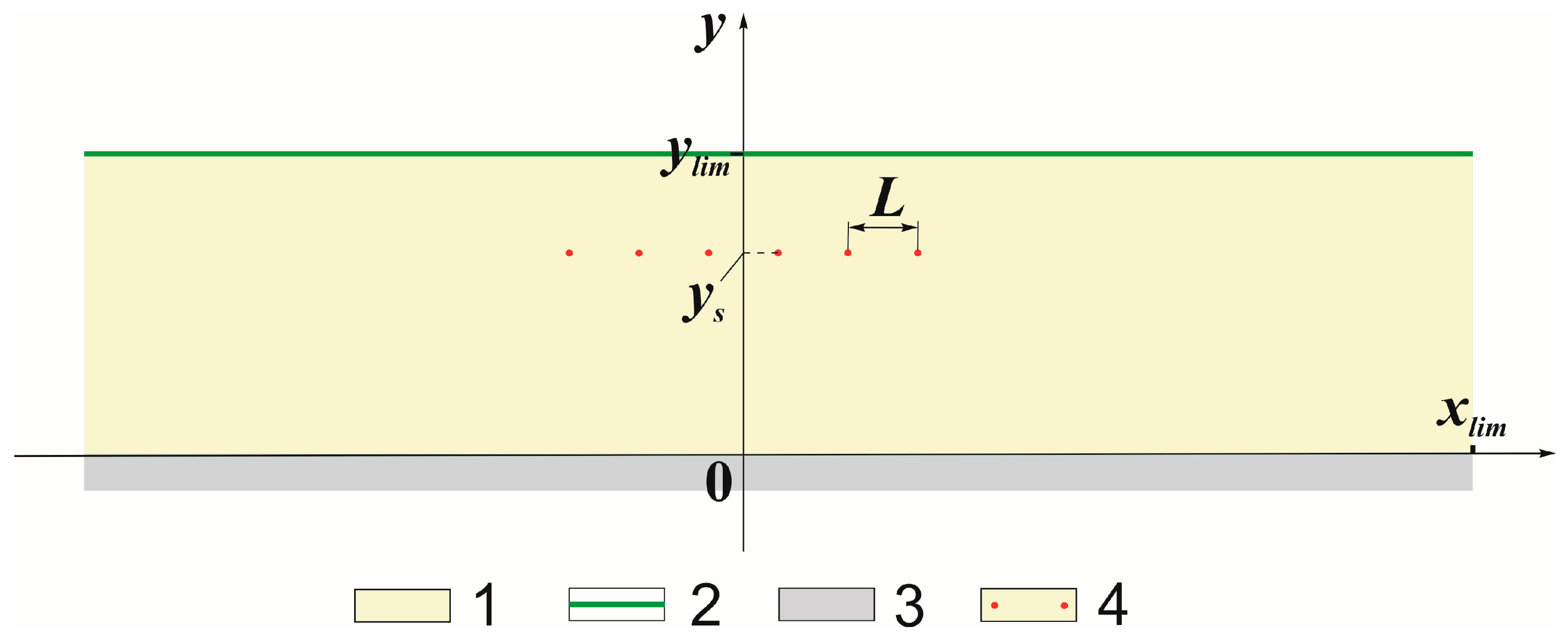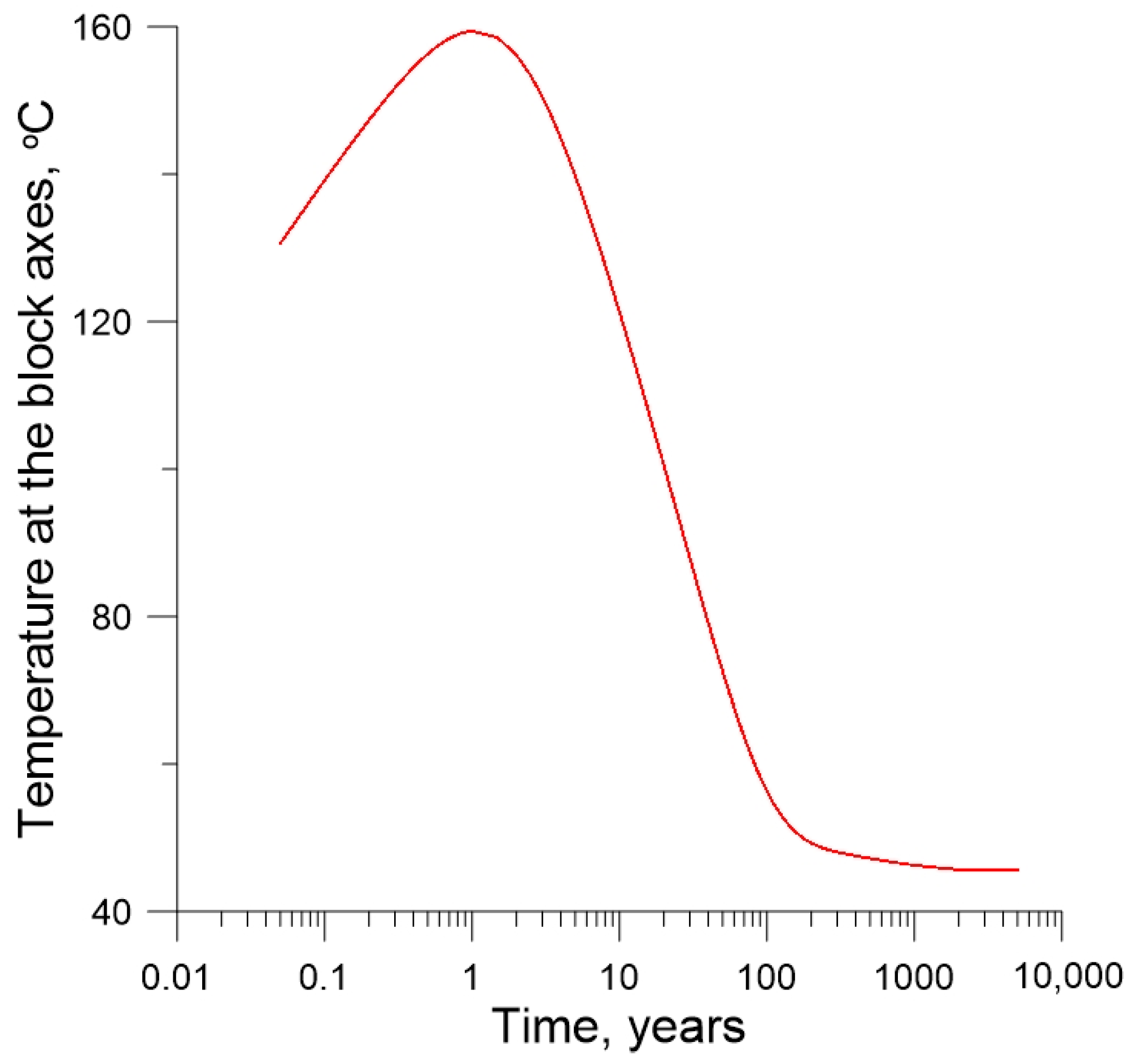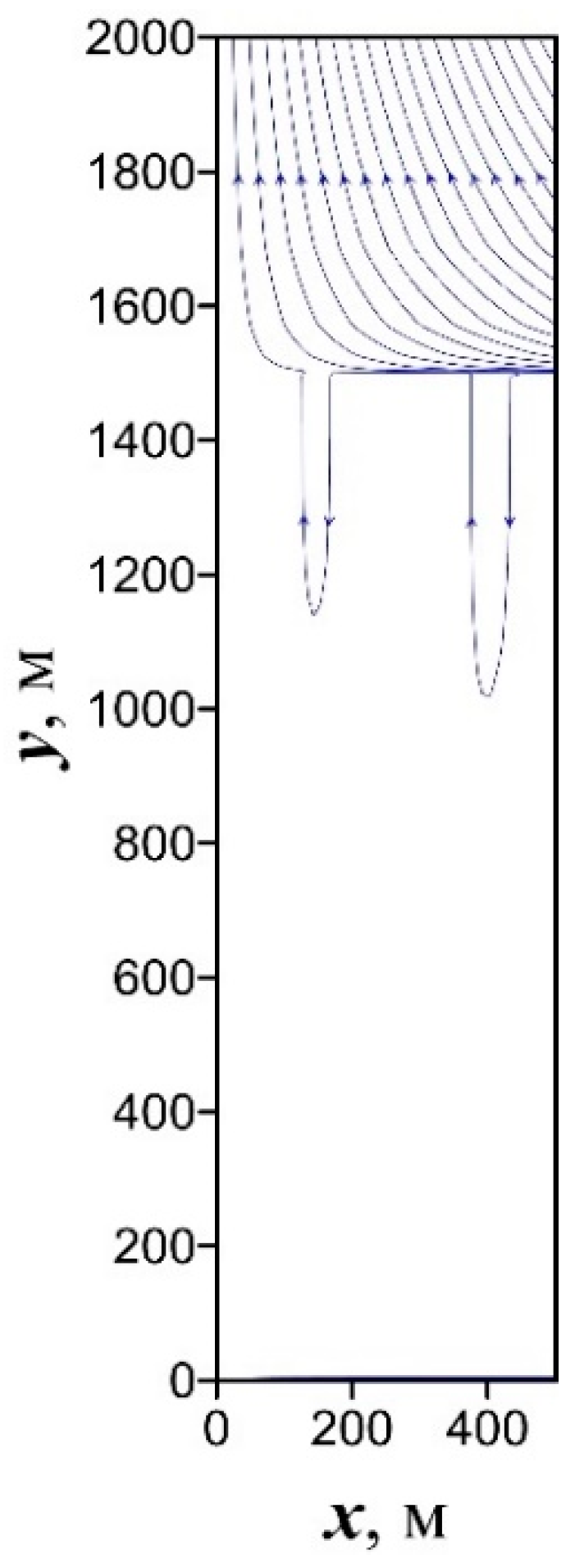Forecast of 241Am Migration from a System of Deep Horizontal Boreholes
Abstract
1. Introduction
- Long-term safety due to the large depth of disposal;
- Economical access to rocks with high insulating properties;
- Weaker requirements for the infrastructure of a borehole GDF and a much smaller area of ground facilities (footprint);
- Significantly shorter time for the construction of a borehole GDF and loading of HLW and its significantly lower cost;
- Possibility of creating a borehole GDF in close proximity of the place of waste production;
- Extremely low probability of unauthorized access to radioactive materials;
- Minimal control after completion of disposal campaign and sealing of the GDF;
- High salinity hinders the development of convection of underground waters due to the heat release of SNF and HLW;
- Waste isolation is facilitated by the low solubility of actinides under reducing conditions.
2. Methods
3. Calculations Results and Discussion
4. Conclusions
Author Contributions
Funding
Institutional Review Board Statement
Informed Consent Statement
Data Availability Statement
Acknowledgments
Conflicts of Interest
References
- Kopyrin, A.A.; Karelin, A.I.; Karelin, V.A. Technology of Production and Radiochemical Processing of Nuclear Fuel; Atomenergoizdat: Moscow, Russia, 2006. (In Russian) [Google Scholar]
- IAEA. Policies and Strategies for Radioactive Waste Management; Nuclear Energy Series No. NW-G-1.1; IAEA: Vienna, Austria, 2009. [Google Scholar]
- NEA. The Economics of the Back End of the Nuclear Fuel Cycle; NEA OECD: Paris, France, 2013.
- Ewing, R.C.; Whittleston, R.A.; Yardley, B.W.D. Geological Disposal of Nuclear Waste: A Primer. Elements 2016, 12, 233–237. [Google Scholar] [CrossRef]
- NEA. Management and Disposal of High-Level Radioactive Waste: Global Progress and Solutions; NEA OECD: Paris, France, 2020.
- Hench, L.L.; Clark, D.E.; Campbell, J. High Level Waste Immobilization Forms. Nucl. Chem. Waste Manag. 1984, 5, 149–173. [Google Scholar] [CrossRef]
- National Academy of Sciences. End Points for Spent Nuclear Fuel and High-Level Radioactive Waste in Russia and the United States/Committee on End Points for Spent Nuclear Fuel and High-Level Radioactive Waste in Russia and the United States; National Academies Press: Washington, DC, USA, 2003. [Google Scholar]
- Gin, S.; Ribet, I.; Peuget, S.; Delaye, J.-M. Long-term Behavior of Glasses. In Nuclear Waste Conditioning; Pansot, J.-F., Ed.; CEA: Paris, France, 2009; pp. 51–64. [Google Scholar]
- Ojovan, M.; Lee, W.E. Glassy Waste Forms for Nuclear Waste Immobilization. Metall. Mater. Trans. A 2011, 42, 837–851. [Google Scholar] [CrossRef]
- Laverov, N.P.; Yudintsev, S.V.; Kochkin, B.T.; Malkovsky, V.I. The Russian strategy of using crystalline rock as a repository for nuclear waste. Elements 2016, 12, 253–256. [Google Scholar] [CrossRef]
- Ojovan, M.I.; Yudintsev, S.V. Glass, ceramic, and glass-crystalline matrices for HLW immobilisation. Open Ceram. 2023, 14, 100355. [Google Scholar] [CrossRef]
- IAEA. Safety Consideration in the Disposal of Disused Sealed Radioactive Sources in Borehole Facilities; IAEA: Vienna, Austria, 2003. [Google Scholar]
- IAEA. Management of Disused Sealed Radioactive Sources; IAEA: Vienna, Austria, 2014. [Google Scholar]
- Hess, H.H.; Adkins, J.N.; Benson, W.E.; Frye, J.C.; Heroy, W.B.; Hubbert, M.K.; Russel, R.J.; Theis, C.W. The Disposal of Radioactive Waste on Land; Report of the Committee on Waste Disposal of the Division of Earth Sciences; National Academy of Sciences: Washington, DC, USA, 1957; 147p. [Google Scholar] [CrossRef]
- O’Brien, M.T.; Cohen, L.H.; Narasimhan, T.N.; Simkin, T.L.; Wollenberg, H.A.; Brace, W.F.; Green, S.; Platt, H.P. The Very Deep Hole Concept: Evaluation of an Alternative for Nuclear Waste Disposal; Lawrence Berkeley Laboratory: Berkeley, CA, USA, 1979. [Google Scholar] [CrossRef][Green Version]
- Ringwood, A.E. Disposal of High-Level Nuclear Wastes: A Geological Perspective. Mineral. Mag. 1985, 49, 159–176. [Google Scholar] [CrossRef]
- Crichlow, H.B. Method of Disposing of Nuclear Waste in Underground Rock Formations. U.S. Patent 5,850,614, 15 December 1998. [Google Scholar]
- von Hippel, D.; Hayes, P. Deep Borehole Disposal of Nuclear Spent Fuel and High-Level Waste as a Focus of Regional East Asia Nuclear Fuel Cycle Cooperation; Nautilus Institute: Berkeley, CA, USA, 2010. [Google Scholar]
- Arnold, B.W.; Bauer, S.; Herrick, C.; Pye, S.; Finger, J.; Brady, P.V. Reference Design and Operations for Deep Borehole Disposal of High-Level Radioactive Waste; Sandia National Laboratories: Albuquerque, NM, USA, 2011; 66p. [CrossRef][Green Version]
- Driscoll, M.J.; Lester, R.K.; Jensen, K.G.; Arnold, B.W.; Swift, P.N.; Brady, P.V. Technology and Policy Aspects of Deep Borehole Nuclear Waste Disposal. Nucl. Technol. 2011, 180, 111–121. [Google Scholar] [CrossRef]
- Swift, P.N.; Arnold, B.W.; Brady, P.V.; Freeze, G.; Hadgu, T.; Lee, J.H. Preliminary Performance Assessment for Deep Borehole Disposal of High-Level Radioactive Waste. Mater. Res. Soc. Symp. Proc. 2012, 1475, 375–384. [Google Scholar] [CrossRef]
- Bates, E.A.; Driscoll, M.J.; Lester, R.K.; Arnold, B.W. Can Deep Boreholes Solve America’s Nuclear Waste Problem? Energy Policy 2014, 72, 186–189. [Google Scholar] [CrossRef]
- Beswick, A.J.; Gibb, F.G.F.; Travis, K.P. Deep Borehole Disposal of Nuclear Waste: Engineering Challenges. Proc. Inst. Civ. Eng. Energy 2014, 167, 47–66. [Google Scholar] [CrossRef]
- Bracke, G.; Charlier, F.; Liebscher, A.; Schilling, F.R.; Röckel, T. About the Possibility of Disposal of HLRW in Deep Boreholes in Germany. Geosciences 2017, 7, 58. [Google Scholar] [CrossRef]
- Bracke, G.; Kudla, W.; Rosenzweig, T. Status of Deep Borehole Disposal of High-Level Radioactive Waste in Germany. Energies 2019, 12, 2580. [Google Scholar] [CrossRef]
- Chapman, N.A. Who Might be Interested in a Deep Borehole Disposal Facility for their Radioactive Waste? Energies 2019, 12, 1542. [Google Scholar] [CrossRef]
- Finsterle, S.; Muller, R.A.; Grimsich, J.; Bates, E.A.; Midgley, J. Post-Closure Safety Analysis of Nuclear Waste Disposal in Deep Vertical Boreholes. Energies 2021, 14, 6356. [Google Scholar] [CrossRef]
- Crichlow, H. Improved Disposal of Intact Spent Nuclear Fuel Assemblies in Ultra Deep Geological Formations in Lateral Boreholes. 2018. Available online: https://www.researchgate.net/publication/330370012 (accessed on 20 July 2023).
- Finsterle, S.; Muller, R.A.; Baltzer, R.; Payer, J.; Rector, J.W. Thermal Evolution Near Heat-Generating Nuclear Waste Canisters Disposed in Horizontal Drillholes. Energies 2019, 12, 596. [Google Scholar] [CrossRef]
- Finsterle, S.; Cooper, C.; Muller, R.A.; Grimsich, J.; Apps, J. Sealing of a Deep Horizontal Borehole Repository for Nuclear Waste. Energies 2021, 14, 91. [Google Scholar] [CrossRef]
- Muller, R.A.; Finsterle, S.; Grimsich, J.; Baltzer, R.; Muller, E.A.; Rector, J.W.; Payer, J.; Apps, J. Disposal of High-Level Nuclear Waste in Deep Horizontal Drillholes. Energies 2019, 12, 2052. [Google Scholar] [CrossRef]
- Krall, L.; McCartin, T.; Macfarlane, A. Siting Deep Boreholes for Disposal of Radioactive Waste: Consequences for Tight Coupling Between Natural and Engineered Systems. Environ. Sci. Technol. 2020, 54, 629–646. [Google Scholar] [CrossRef]
- Kochkin, B.; Malkovsky, V.; Yudintsev, S.; Petrov, V.; Ojovan, M. Problems and Perspectives of Borehole Disposal of Radioactive Waste. Prog. Nucl. Energy 2021, 139, 103867. [Google Scholar] [CrossRef]
- Kochkin, B.T.; Bogatov, S.A. Borehole RW Disposal Concept and Prospects of its Implementation in Russia. Radioact. Waste 2022, 2, 85–99. [Google Scholar] [CrossRef]
- Grigoryan, A.M. Removal of Reservoirs by Multilateral and Horizontal Wells; Nedra: Moscow, Russia, 1969. (In Russian) [Google Scholar]
- Kristiansen, H.; Rapić, A.; Thomsen, H.S.; Kegel, L.; Vuorio, M.; Neckel, W. Boreholes as a Permanent Solution for National Inventories of Radioactive Waste; European Repository Development Organisation (ERDO): Gipf-Oberfrick, Switzerland, 2022. [Google Scholar]
- Swift, P.; Newman, A. Deep Borehole Disposal of Radioactive Waste: Next Steps and Applicability to National Programs; Centre on Global Energy Policy, Columbia SIPA, Columbia University’s School of International and Public Affairs: New York, NY, USA, 2022. [Google Scholar]
- Deep Borehole Demo Work to Be Conducted in Norway. WNN, 9 June 2023. Available online: https://world-nuclear-news.org/Articles/Deep-borehole-demo-work-to-be-conducted-in-Norway (accessed on 18 July 2023).
- Study into Deep Borehole Disposal Costs at Krško. WNN, 10 July 2023. Available online: https://www.world-nuclear-news.org/Articles/Study-into-deep-borehole-disposal-costs-at-Krsko (accessed on 18 July 2023).
- IAEA. Retrievability of High-Level Waste and Spent Nuclear Fuel; TECDOC-1187; IAEA: Vienna, Austria, 2000. [Google Scholar]
- Lari, K.S.; Mallants, D. Coupled Heat-Mass Transport Modelling of Radionuclide Migration from a Nuclear Waste Disposal Borehole. Geofluids 2022, 2022, 5264257. [Google Scholar] [CrossRef]
- Malkovsky, V.; Yudintsev, S. Numerical Analysis of Safety of a Borehole Repository for Vitrified High-level Nuclear Waste. Prog. Nucl. Energy 2022, 144, 104075. [Google Scholar] [CrossRef]
- Zotov, A.V.; Levin, K.A.; Magazina, L.O.; Mukhamet-Galeev, A.P.; Omel’yanenko, B.I.; Samotoin, N.D.; Shapovalov, Y.B. Interaction of Aluminophosphate Glass with Water at Elevated Temperatures. Geochem. Int. 1996, 34, 805–817. [Google Scholar]
- Martynov, K.V.; Zakharova, E.V. Leaching Factors for a Phosphate Radioactive Waste Form under Deep Disposal Conditions. Radioact. Waste 2023, 2, 63–81. [Google Scholar] [CrossRef]
- Yudintsev, S.V.; Malkovsky, V.I.; Kalenova, M.Y. The Thermal Field around a Borehole Repository of Radioactive Waste. Dokl. Earth Sci. 2021, 498, 525–532. [Google Scholar] [CrossRef]
- de Marsily, G. Quantitative Hydrogeology; Academic Press: Orlando, FL, USA, 1986. [Google Scholar]
- Gebhart, B.; Jaluria, Y.; Mahajan, R.L.; Sammakia, B. Buoyancy-Induced Flows and Transport; Hemisphere Publishing Co.: Washington, DC, USA, 1988. [Google Scholar]
- Roache, P. Computational Fluid Dynamics; Hermosa Publishers: Albuquerque, NM, USA, 1976. [Google Scholar]
- Zienkiewicz, O.C.; Morgan, K. Finite Elements and Approximation; John Wiley and Sons: New York, NY, USA, 1983. [Google Scholar]
- Bredehoeft, J.D.; Norton, D.L. Mass and Energy Transport in a Deforming Earth’s Crust. In The Role of Fluids in Crustal Processes; National Academy Press: Washington, DC, USA, 1990; pp. 27–41. [Google Scholar]
- Fried, J.J. (Ed.) Groundwater Pollution: Theory, Methodology, Modelling, and Practical Rules; Elsevier: Amsterdam, The Netherlands, 1975. [Google Scholar] [CrossRef]
- Penrose, W.R.; Polzer, W.L.; Essington, E.H.; Nelson, D.M.; Orlandini, K.A. Mobility of Plutonium and Americium through a Shallow Aquifer in a Semiarid Region. Environ. Sci. Technol. 1990, 24, 228–234. [Google Scholar] [CrossRef]
- Kersting, A.B.; Efurd, D.W.; Finnegan, D.L.; Rokop, D.J.; Smith, D.K.; Thompson, J.L. Migration of Plutonium in Ground Water at the Nevada Test Site. Nature 1999, 397, 56–59. [Google Scholar] [CrossRef] [PubMed]
- Honeyman, B.D. Colloidal Culprits in Contamination. Nature 1999, 397, 23–24. [Google Scholar] [CrossRef]
- Malkovsky, V. Theoretical Analysis of Colloid-facilitated Transport of Radionuclides by Groundwater. In Actinide Nanoparticle Research; Kalmykov, S.N., Denecke, M.A., Eds.; Springer: Berlin, Germany, 2011; pp. 195–243. [Google Scholar]
- Malkovsky, V.I.; Yudintsev, S.V.; Aleksandrova, E.V. Influence of Na-Al-Fe-P Glass Alteration in Hot Non-saturated Vapor on Leaching of Vitrified Radioactive Wastes in Water. J. Nucl. Mater. 2018, 508, 212–218. [Google Scholar] [CrossRef]
- Bates, J.K.; Seitz, M.G.; Steindler, M.J. The Relevance of Vapor Phase Hydration Aging to Nuclear Waste Isolation. Nucl. Chem. Waste Manag. 1984, 5, 63–73. [Google Scholar] [CrossRef]
- Malkovsky, V.I.; Yudintsev, S.V.; Zharikov, A.V. Radiocolloid Retention in the Nizhnekanskii Rock Massif. Dokl. Earth Sci. 2022, 503, 226–231. [Google Scholar] [CrossRef]
- National Environment Agency (NEA). Engineered Barrier Systems and the Safety of Deep Geological Repositories; NEA OECD: Paris, France, 2003.
- Apted, M.J.; Ahn, J. Repository 101: Multiple-barrier Geological Repository Design and Isolation Strategies for Safe Disposal of Radioactive Materials. In Geological Repository Systems for Safe Disposal of Spent Nuclear Fuels and Radioactive Waste, 2nd ed.; Apted, M.J., Ahn, J., Eds.; Woodhead Publishing Series in Energy; Elsevier Ltd.: Amsterdam, The Netherlands, 2017; pp. 3–26. [Google Scholar] [CrossRef]
- Petrov, V.A.; Yudintsev, S.V. Mineral Resources of the Russian Nuclear Industry and Isolation of Radioactive Waste. Geol. Ore Depos. 2023, 65, 469–480. [Google Scholar] [CrossRef]
- Ojovan, M.I. Challenges in the Long-Term Behaviour of Highly Radioactive Materials. Sustainability 2022, 14, 2445. [Google Scholar] [CrossRef]
- Malkovsky, V.I.; Yudintsev, S.V.; Ojovan, M.I.; Petrov, V.A. The Influence of Radiation on Confinement Properties of Nuclear Waste Glasses. Sci. Technol. Nucl. Install. 2020, 14, 8875723. [Google Scholar] [CrossRef]






| № | k, m2 | Nb | Distance between Boreholes, m | Borehole Depths, m | tmax, Years | Storage Time Prior to Disposal, Years | Csup |
|---|---|---|---|---|---|---|---|
| 1 | 10−16 | 6 | 250 | 1000 | 3886 | 75 | 4.45 × 10−20 |
| 2 | 10−15 | 6 | 250 | 1000 | 2860 | 75 | 3.50 × 10−14 |
| 3 | 10−16 | 4 | 250 | 1000 | 4226 | 75 | 1.18 × 10−22 |
| 4 | 10−16 | 6 | 250 | 1000 | 3858 | 50 | 5.01 × 10−20 |
| 5 | 10−16 | 6 | 250 | 500 | 1065 | 75 | 1.31 × 10−10 |
| 6 | 10−16 | 6 | 100 | 1000 | 3720 | 75 | 3.68 × 10−20 |
Disclaimer/Publisher’s Note: The statements, opinions and data contained in all publications are solely those of the individual author(s) and contributor(s) and not of MDPI and/or the editor(s). MDPI and/or the editor(s) disclaim responsibility for any injury to people or property resulting from any ideas, methods, instructions or products referred to in the content. |
© 2023 by the authors. Licensee MDPI, Basel, Switzerland. This article is an open access article distributed under the terms and conditions of the Creative Commons Attribution (CC BY) license (https://creativecommons.org/licenses/by/4.0/).
Share and Cite
Malkovsky, V.; Yudintsev, S.; Ojovan, M. Forecast of 241Am Migration from a System of Deep Horizontal Boreholes. Sustainability 2023, 15, 15134. https://doi.org/10.3390/su152015134
Malkovsky V, Yudintsev S, Ojovan M. Forecast of 241Am Migration from a System of Deep Horizontal Boreholes. Sustainability. 2023; 15(20):15134. https://doi.org/10.3390/su152015134
Chicago/Turabian StyleMalkovsky, Victor, Sergey Yudintsev, and Michael Ojovan. 2023. "Forecast of 241Am Migration from a System of Deep Horizontal Boreholes" Sustainability 15, no. 20: 15134. https://doi.org/10.3390/su152015134
APA StyleMalkovsky, V., Yudintsev, S., & Ojovan, M. (2023). Forecast of 241Am Migration from a System of Deep Horizontal Boreholes. Sustainability, 15(20), 15134. https://doi.org/10.3390/su152015134







